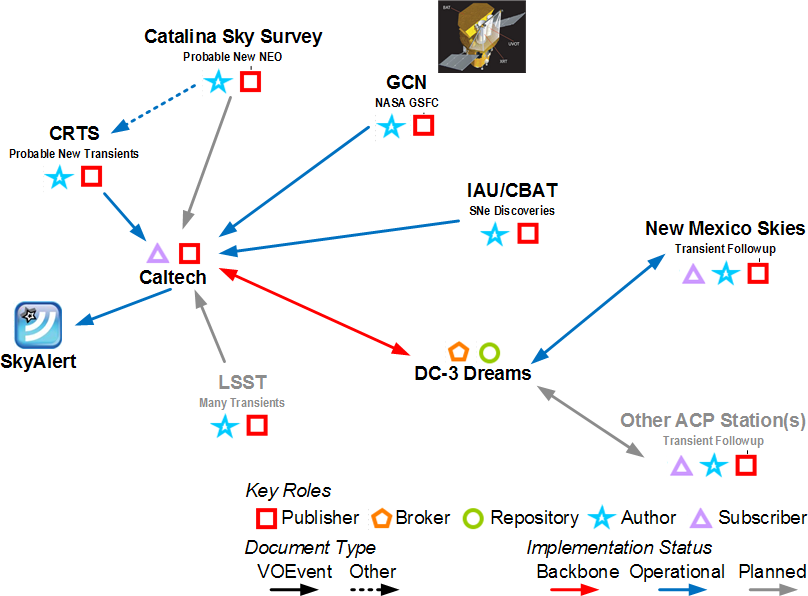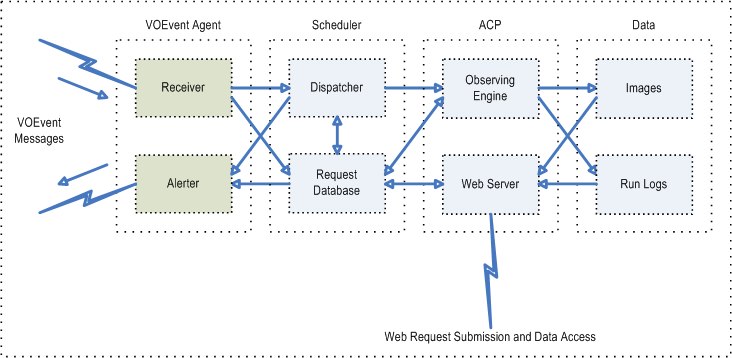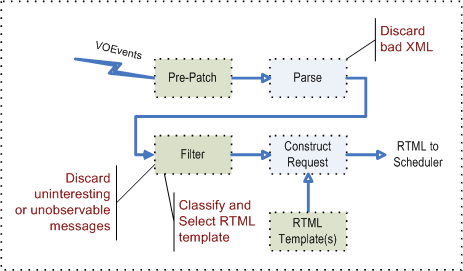
Be sure to follow the directions in Getting Started before starting the VOEvent Receiver!
This page gives only the bare essentials on VOEvent and the VOEvent Receiver (and alerter). You really should at least skim-read Transient Astronomy With ACP Scheduler before trying to use it. There's a lot of capability and flexibility here.
VOEvent is part of the International Virtual Observatory, an effort to tie individual observatories and data repositories around the world together to gain synergy. VOEvent is a system by which an observatory can send out a message indicating that some timely event has been observed or predicted. Examples include gamma ray bursts, supernovae, cataclysmic variable outbursts, radio outbursts, microlensing events, etc. The idea is to provide a timely alert of these events so that others can acquire data to assist in analysis.
Here is a diagram of the VOEvent network as of early 2011:

The hubs (brokers) are at Caltech and eStar Exeter, with a semi-private one at Los Alamos National Laboratory (LANL). By activating your VOEvent Receiver, you are adding yourself to the above network with a solid blue arrow pointing toward the broker. If you activate the alerter, your connection becomes a bidirectional solid blue arrow. The broker serves as a relay. Messages from an observatory go to the broker, which distributes copies to all observatories who are connected to any broker. Brokers send to other brokers
The VOEvent Receiver connects to the worldwide VOEvent network (see diagram above) via a broker. It listens for VOEvent messages. When one arrives, it decides (based on your settings and the target's observability) whether the event is "interesting" to your system. If so, it automatically enters an observing request into Scheduler. If the event is time-critical (e.g. GRBs need followup in seconds not minutes), it can interrupt the Scheduler and force it to start the followup observation immediately.
The VOEvent Alerter (part of the Receiver) lets the rest of the network know when you have completed some followup observations. The Alerter sends a VOEvent message out to the network, telling others that you have taken data in response to some received event, and making your data available to others. It also makes the data available via ACP's web server through a special set of web pages and references these web pages (and the data itself) in the VOEvent message it sends out.
![]() Web access to your data is restricted to those who have accounts on the ACP web server. The data is not publicly available. The need to have access granted is noted in comments in the VOEvent message.
Web access to your data is restricted to those who have accounts on the ACP web server. The data is not publicly available. The need to have access granted is noted in comments in the VOEvent message.
Here's how the receiver and alerter fit into the ACP – ACP Scheduler system:

When a VOEvent arrives, the XML is first pre-patched and parsed/validated to remove known XML errors. It then gets filtered to discard uninteresting events. You have control over this at several levels. An accepted event is then used to build an observing request (in RTML) for submission to the Scheduler's database. You have virtually unlimited control over this. Optionally, a submitted observation can be considered time-critical, causing any currently executing Plan to be immediately stopped and forcing the VOEvent observations to be started. Here's a flow diagram of the receiving process:

If you enable the Alerter (part of the VOEvent Receiver), it will send a VOEvent alert announcing completion of your follow-up observing (which was done in response to come VOEvent received earlier). When any observing Plan is completed, the alerter is signaled. If the completed Plan matches one that the receiver submitted for a VOEvent, it knows to send a completion alert. The completion alert contains information about your observatory and information about each image that was acquired while doing follow up observing. It also contains URLs of the data, as well as the URL to a special web-accessible site via which all VOEvent followup data can be accessed.
In addition, the alerter can be set to send email messages on completion.